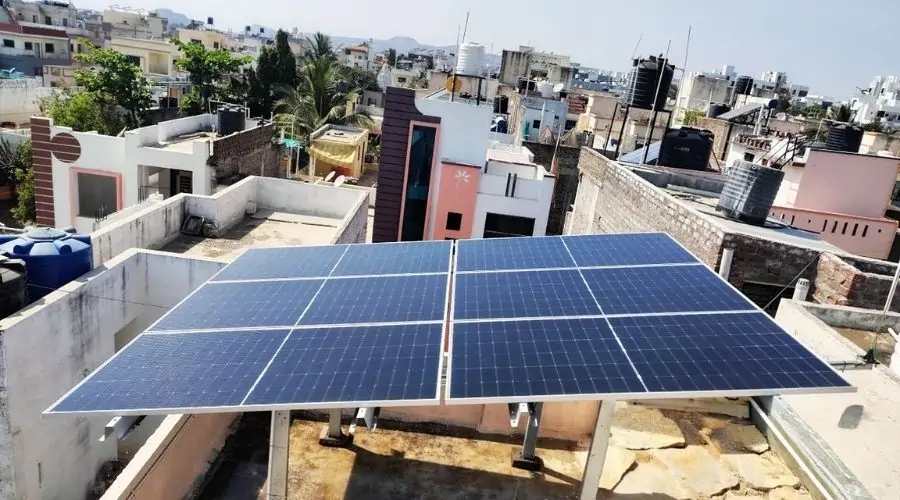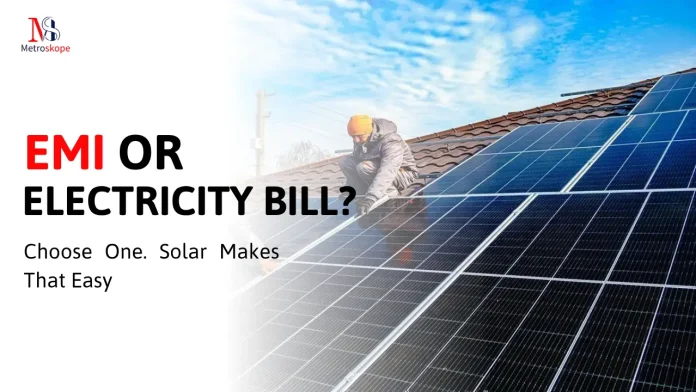In 2025, Indian households face a choice: keep paying rising electricity bills or switch to solar and pay affordable EMIs for free electricity.
With India ranking third globally in solar power generation, producing 110.83 GW as of May 2025, solar panels are transforming homes into powerhouses.
The PM Surya Ghar Muft Bijli Yojana offers subsidies up to ₹78,000, making rooftop solar accessible for middle-class families.
This article explores how solar panels can eliminate electricity bills, the financial benefits of EMI-based installations, and why 2025 is the perfect year to go solar in India.
Why Solar in 2025?
India’s solar revolution is booming, with 100.33 GW of installed capacity by January 2025 and 35–40 GW expected additions this year. The government’s push for 500 GW of renewable energy by 2030, backed by schemes like PM Surya Ghar, makes solar affordable through subsidies and low-cost EMI plans.
Solar panels reduce electricity bills by up to 90%, offer net metering credits for excess power, and align with India’s net-zero carbon goal by 2070.
For Indian homeowners, solar means financial savings, energy independence, and a step toward sustainability in a country receiving 4–7 kWh/sq.m of solar energy daily.
How Solar Eliminates Electricity Bills
A 3kW solar system, ideal for small to mid-sized Indian homes, generates 12–15 units daily, covering 360–450 units monthly—enough for essentials like fans, lights, and an AC.
With net metering, surplus energy is fed back to the grid, earning credits that offset rainy days or high-usage months. For a household with a ₹3,000 monthly bill (300 units at ₹10), solar can save ₹30,000–36,000 annually.
After recovering the installation cost in 4–6 years, you enjoy free electricity for 20+ years, as panels last 25–30 years with minimal maintenance.
PM Surya Ghar Muft Bijli Yojana: Subsidies Galore
Launched in February 2024, the PM Surya Ghar Yojana aims to solarize 1 crore households, offering up to 300 units of free electricity monthly.
Subsidies include ₹30,000/kW for up to 2kW, ₹18,000/kW for 2–3kW, and a fixed ₹78,000 for systems above 3kW. For a 3kW system costing ₹1.8–2.4 lakh, subsidies reduce costs to ₹1.02–1.62 lakh.

Eligibility requires a valid electricity connection, no prior solar subsidies, and installation via MNRE-approved vendors. Over 95 lakh households registered by April 2025, reflecting massive adoption.
| System Size | Cost (₹) | Subsidy (₹) | Net Cost (₹) | Monthly Savings (₹) |
|---|---|---|---|---|
| 2kW | 1,20,000–1,60,000 | 60,000 | 60,000–1,00,000 | 2,000–2,500 |
| 3kW | 1,80,000–2,40,000 | 78,000 | 1,02,000–1,62,000 | 2,500–3,500 |
| 5kW | 3,50,000–4,50,000 | 78,000 | 2,72,000–3,72,000 | 4,000–6,000 |
Solar on EMI: A Game-Changer
Worried about upfront costs? Solar companies like Freyr Energy and Morca offer no-cost EMI plans, spreading payments over 3–5 years. For a 3kW system costing ₹1.8 lakh, post-subsidy (₹1.02 lakh), EMI could be ₹2,833/month (36 months, 8% interest), cheaper than many electricity bills.
Banks like SBI and HDFC provide solar loans with fast approvals, and subsidies are credited post-installation, reducing financial stress. X posts highlight real savings, with users like @IThinkItsBLaw reporting zeroed-out bills after solar adoption.
How to Apply for Solar Subsidies
Applying for PM Surya Ghar is simple via pmsuryaghar.gov.in:
- Register with your mobile number, state, district, and DISCOM.
- Submit electricity bill, proof of roof ownership, and KYC documents.
- Await DISCOM’sAid: feasibility approval (15 days).
- Choose an MNRE-approved vendor for installation.
- Submit installation details and apply for net metering.
- Upload bank details and a cancelled cheque for subsidy disbursement.
The process takes 2–4 weeks, with vendors like Freyr Energy guiding you.
Environmental and Economic Benefits
Solar panels produce clean energy, reducing carbon emissions by 1.5–2 tons annually per household. They lower reliance on coal, which powers 70% of India’s electricity, aiding the 2070 net-zero goal.
Economically, solar saves ₹30,000–70,000 yearly on bills, increases property value by 3–4%, and offers tax benefits like accelerated depreciation for businesses. Rural households benefit from off-grid systems, replacing kerosene lamps and improving health.
| Benefit | Impact |
|---|---|
| Bill Savings | ₹30,000–70,000/year for 3–5kW systems |
| Carbon Reduction | 1.5–2 tons/year per household |
| Property Value | 3–4% increase |
| ROI Period | 4–6 years |
Quick Summary
- What: Rooftop solar panels eliminate electricity bills via PM Surya Ghar Yojana.
- Cost: ₹1.2–4.5 lakh for 2–5kW systems; subsidies up to ₹78,000.
- EMI: Pay ₹2,000–4,000/month, cheaper than bills.
- Savings: ₹30,000–70,000/year; ROI in 4–6 years.
- Subsidy: ₹30,000/kW (up to 2kW), ₹18,000/kW (2–3kW), max ₹78,000.
- Benefits: Zero emissions, energy independence, increased property value.
- Action: Apply at pmsuryaghar.gov.in; choose MNRE-approved vendors.
- Why 2025: 23% subsidy increase, simplified process, 35–40 GW solar growth.
Choosing the Right System
A 2kW system suits small households (200–300 units/month), while 3–5kW systems fit larger homes (400–600 units). On-grid systems with net metering are cost-effective for urban areas, while off-grid systems with batteries suit remote locations.
Monocrystalline panels, offered by vendors like Waaree, are 20–22% efficient and ideal for India’s sunny climate (300 sunny days/year). Consult empanelled vendors like Freyr Energy or Citizen Solar for roof assessments.
Challenges and Solutions
Challenges include high initial costs (₹60,000–80,000/kW), space requirements (100 sq.ft./kW), and maintenance (annual cleaning). Subsidies, EMIs, and financing from banks address costs, while modular designs suit small roofs.
Weather impacts (e.g., monsoons) are mitigated by net metering or batteries. X posts, like @solaretribe’s, emphasize easy consultations to overcome barriers.
Why Now?
In 2025, solar panel prices are at record lows (₹45,000–80,000/kW), and subsidies have increased by 23%. India’s 500 GW renewable target by 2030, with 250 GW from solar, signals strong policy support.
Rising electricity tariffs (₹8–12/unit) make solar’s ROI faster. With 5,000 trillion kWh of solar energy potential annually, India is a solar powerhouse, and 2025 is the year to act.
Choosing between EMI and electricity bills is easy with solar in 2025. Subsidized rooftop systems, EMI options, and net metering make solar affordable and profitable, saving ₹30,000–70,000 yearly while cutting emissions.
Apply for PM Surya Ghar Yojana at pmsuryaghar.gov.in, choose trusted vendors like Freyr Energy or Waaree, and power your home sustainably. Visit metroskope.in for more renewable energy insights and start your solar journey today.

